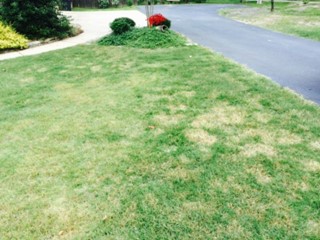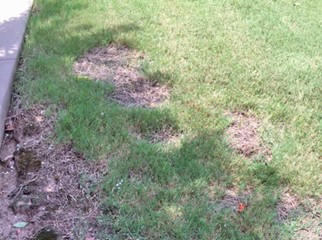Arkansas Plant Health Clinic Disease Notes
Contact
Plant Diagnostician
Phone: (479) 575-2727
Email: ssmith@uada.edu
Jason Pavel
Diagnostician
Phone: (479) 575-7257
Email: jpavel@uada.edu
University of Arkansas System Division of Agriculture
Cralley Warren Building
Room 16
2601 N. Young Ave.
Fayetteville, AR 72704
Turf Spring Dead Spot
by Sherrie Smith and Jason Pavel - March 16, 2023
Plant Health Clinic Disease Note: Issue 4
Although early in the spring we are starting to see Spring Dead Spot on Bermuda. Spring Dead Spot, caused by Ophiosphaerella spp., typically occurs on Bermuda plantings three or more years old and is the most important disease of Bermuda grass in North America.

Bermuda Spring Dead Spot- Ophiosphaerella spp. (Photo by Brad McGinley, University of Arkansas System Cooperative Extension Service)
What are the symptoms of Spring Dead Spot in Bermuda grass?
Infections begin in the fall with damaged areas becoming visible in the spring. Symptoms begin as circular depressed areas prior to spring green-up. When the turf greens up, circular patches of dead, bleached grass are apparent. The dead spots may be from 6 inches to as large as 3 feet in diameter.
After several years, the centers of active patches may contain weeds or live bermudagrass, with the patches taking the form of rings or serpentine arcs. The roots and stolons are severely rotted in these areas. Re-growth is extremely slow. Bermuda that re-colonizes the necrotic areas remains stunted due to toxins produced by the fungi.
How do I control Spring Dead Spot?
Adequate control of Spring Dead Spot is mainly through cultural practices. Recommendations are core aeration done in August or September and practices that reduce soil compaction and improve drainage. Applications of ammonium sulfate and potassium have been found to be helpful when applied in summer. Apply at least 1.0 lbs. of Potassium (K2O) per 1000 sq. ft. to turfgrass during June, July, or August.

Bermuda Spring Dead Spot - Ophiosphaerella spp. (Photo by Brannon Thiesse, University of Arkansas System Cooperative Extension Service)
Some experts recommend two fall applications that are three to four weeks apart. Maintain the pH in the range of 5.5-6.5. Fungicide treatments are not effective unless coupled with good cultural practices. Heritage, ProPensity, Disarm, Eagle, and Torque may be used by commercial lawn care professionals. Homeowners may use Scotts Disease EX Lawn Fungicide; or Bonide Infuse Systemic Disease Control Lawn and Landscapes; or Spectracide Immunox Fungus plus Insect Control for Lawns; or Ferti-lome F- Stop Liquid Fungicide. Make applications about 30 days before dormancy in the fall when soil temperatures are between 60ºF and 80ºF. Follow the label for specific instructions. Cultivars with good winter hardiness are less affected by Spring Dead Spot.
Take Aways: contributing factors
- Soil compaction
- Poor soil drainage
- Excessive thatch plus rainy weather
- Excessive nitrogen, especially late season
- Potassium deficiency
Follow us on Facebook!
This work is supported by the Crop Protection and Pest Management Program [grant no. 2017-70006- 27279/project accession no. 1013890] from the USDA National Institute of Food and Agriculture.